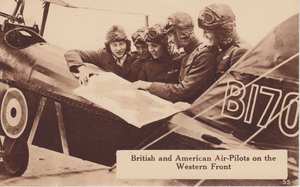From Parr’s Pilot’s Flying Log Book:
9:10–11:25 31 My 18 AM NE 15 B8374 Solo 18000 Duai. [sic] Saw 1 flight of Huns at a distance, tried to get down to one single Hun.
6:10 to 6:30 31 My 18 PM N.E. Viper SE B 331 Solo 5000 Bouvois [sic] to St. Andrae Callander [sic] & I joy riding to ASD to see deserter Hun D.W.F.
7:00 to 7:35 31 My 18 PM NE B 331 Solo 5000 St. Andrae, Paris Plague [sic] & Bouvois [sic] Escorting Hun & seeing the coast.
The plane Parr flew the evening of the 31st was almost certainly not B 331, which was a DH–5.457 Although No. 32 Squadron had used the DH–5, these had been superseded and replaced by S.E.5a’s by early March 1918.458 Moreover, in addition to Parr’s identifying his substitute plane as a Viper SE, he would almost certainly have remarked in his letter upon flying a different type of plane had he flown a DH–5. The R.F.C./R.A.F. No. 32 Squadron Record Book for this date indicates he actually flew S.E.5a B131 (not, as I earlier speculated, B8331).459
“St. Andrae” probably refers to Gouy-Saint-André, a village about eighteen miles west of St. Pol, or to the nearby aerodrome, or to the Abbaye de Saint-André-aux-Bois, about a mile west-northwest of the village, which had been transformed into a chateau in the eighteenth century and which was used by the R.F.C./R.A.F. as its headquarters off and on starting in March of 1916.460 Parts of the No. 2 Aeroplane Supply Depot (A.S.D.) had moved to this area in March, 1918, as the German spring offensive pushed the front westwards.461
“D.W.F.” should probably be “D.F.W.,” which would indicate any of a number of aircraft designed by the Deutsche Flugzeugwerke. D.F.W. C287/16 was forced down on this day and was, perhaps, the one in question.462 Parr and Callender probably then flew on to Le-Touquet-Paris-Plage, the resort town on the coast.
7:05 to 9:20 1 J 18 AM 15 NE B8374 Solo 18000 Amiens & Somme O.P. no Huns. Puisieux burning.
8:30 to 10:30 2 J 18 AM 5 NE B170 Solo 12000 S.E. of Arras O.P. Saw 2 Albatross could not get to them.
3:50 to 6:10 2–J–18 P.M. 5 N.W. B170 Solo 17500 Bapaume Douai Saw 3 Albatross but could not get near
9 to 10:15 3–J–18 A.M. N.W. B170 Solo 6000 Beauvois to Beauvais Thick clouds 300 to 1500. Squadron moving S to new airdrome. Jerry tied to bomb rack damaged controls. I Landed at wrong airdrome.
On May 27, Ludendorff had begun “Operation Blücher-Yorck” (the third phase of the Spring Offensive) against the French Sixth Army on the River Aisne, seeking to draw strength and attention away from the more northerly British Flanders-Lys sector while moving towards Paris and aiming to drive a wedge between the British and French armies. As a result of the action here and of the initial phase (Operation Michael) of March 21 directed towards Amiens, Ludendorff had created two salients, and the next attack (Operation Gneisenau) aimed to smooth the line out by moving westwards towards Compiègne between Montdidier and Noyon. This offensive (also referred to as Montdidier-Noyon and as the Battle of Matz) was planned for June 9, 1918. The Allies, using information from reconnaissance, deserters, and cracked code, were informed in advance about Operation Gneisenau.463
32 squadron’s move south to Fouquerolles near Beauvais was related to these developments. “Following a request from General Foch on 29 May for air reinforcements on the French front, anticipating a German offensive, IX Brigade deployed most of its squadrons [including 32] and the two Wing HQ’s to the Beauvais area arriving on 3 June.”464
I am puzzled by the “Jerry” tied (“jerry-tied”?) to Parr’s bomb rack, but he was not alone in using his bomb rack for transporting things other than bombs. Rogers, writing on June 6, 1918, about the move remarks that “I came down with two large hams and a pair of boots tied to my bomb rack.”
12:40 to 12:55 4–J–18 P.M. B170 Solo 3000 80 Squad. to 32 Squad. Drome Look at Beauvais bringing my bus. home.
7:00 to 8:15 4–J–18 PM NW B170. Solo 8000 Herelle, Compiegne Fouquerolles Seeing the lines. Clouds.
2:15 to 4:05 5–J–18 PM 10 NW B170 Solo 7000 Line Pat. Montdidier Noyen [sic]. Clouds, bumps 1st Trip with Capt Tirrel [sic].
Captain Walter Alexander Tyrrell. See Parr’s remarks about him (“our regular leader”) in the following letter.

B8374 was the S.E.5a normally flown by Captain Walter Alexander “Bing” Tyrrell.456 It was apparently being used by other pilots while Tyrrell was on leave. (On Tyrrell, see Parr’s letter of June 5, 1918.)